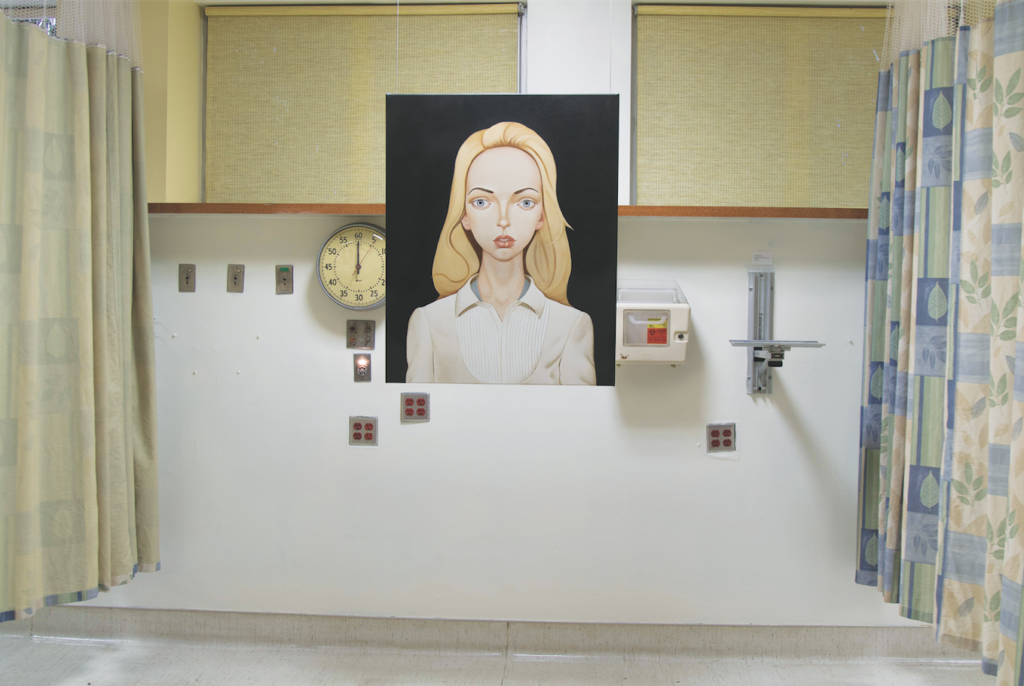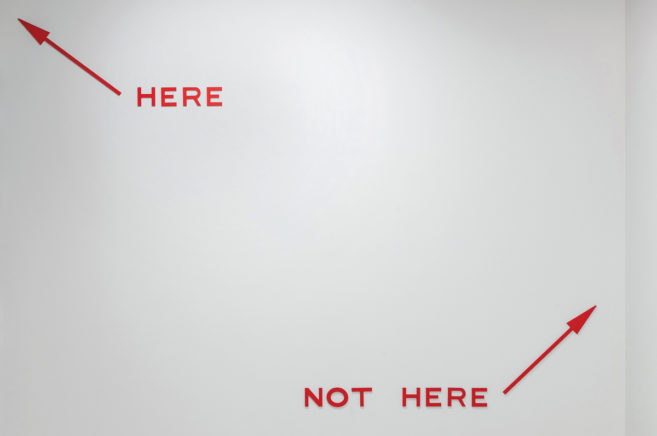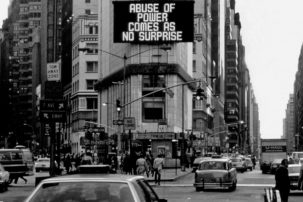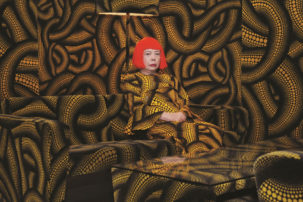I first became aware of the elves on the ceiling when I diverted my eyes from my dad’s hospital bed, where the neurology resident was engaging him in another round of tests to determine how responsive his muscles were. Push my hand away. Touch your nose. Lift your left leg. His leg shot up and a hospital gown is flimsy, so my eyes slid up the wall to the ceiling and came to rest on a bright-blue figure with half a face, ringed by others, all of them a different, thick, primary colour, parading across the Styrofoam panels. I saw that their faces were turned to the side and the points on their heads were spritely hats. Also involved: psychedelic toadstools, some Mothra-scaled butterflies, and sentient apples, I think.
I forgot, for a few seconds, that I was in an emergency room, transported by some ghoulish sprites from my dad’s bedside and the new, developing reality that he’d just had a major stroke.
There can be a sense that you are the very first person seeing the art around hospitals, recognizing it as something different from the medical equipment sprouting from the wall, or the wall itself. Art in hospitals is a relatively new thing, and even newer still is support and engagement for the therapeutic effects art can have on patients and their families, as well as hospital staff. Because of this, it seems most hospital art is a tertiary feature, coming after care and food, hung by somebody who has been instructed to do so, with 10 other places to be. I am grateful that a scrubbed-in team of brain surgeons paid more attention to my dad on his arrival than to the question of what lighting might have enhanced the ayahuasca-trip art on
the ceiling, but, for some people, hospitals function as a first or last museum.
“It’s not just about hanging it anywhere. There has to be curation to the artwork, and I don’t think there’s been a lot of that going on,” says Gary Blair, co-founder of the Art For Healing Foundation, which he started with his partner, Earl Pinchuk, in 2002 after a close friend of theirs, an artist himself, died of HIV-related complications in Montreal’s Royal Victoria Hospital. After a life surrounded by colour, their friend spent his last days staring at a blank wall.
“We turned around from where he lay and looked at the empty wall,” Blair told me. “That was a stark reminder of what can be somebody’s last visual as they exit this world.”
Everything is on display in a hospital. We shy away from the subjects of sickness and death in the wider world, but these formalities evaporate upon entering the airlock doors of an ER, or being buzzed into a cordoned-off wing. There is no time for discretion when you’re in a place where people’s lives are being persuaded in varying degrees of urgency, and privacy is going
to be interrupted at regular intervals either by staff or other patients. You learn when to avert your eyes to afford an anxious family some seclusion, when to tune out the howling of someone in restraints. How you react matters very little to the outcome. Mostly you need to stay out of the way.
With a shortage of beds, or people waiting for rooms, art, of course, seems the last thing on anybody’s minds. Blair and Pinchuk spoke to me about the bureaucracy and internal politics that can stall their process, or halt it completely. Fragmented hospital departments rarely allow for a “vision for the entire building,” as they put it. Art isn’t approached as a top-down project because it isn’t top of mind.
Volunteer curator gigs or private foundations like Art for Healing learn by trial and error. Stuff like: paintings with a lot of red are generally no-go’s for the correlation to blood. In departments with dementia patients, circles are known to cause distress, as are non-representational blotches of colour. Landscapes are generally preferred in palliative centres, or old photographs of a city itself, to jog an aging mind.
Given that the overall scope of art’s place and potential within our healing institutions is still in such an early—and promising—state of development, hospital art collections might best be managed by curators without institutional backgrounds, if the primary function of art in hospitals is to promote positive psychological or physiological reactions.
[ctt template=”2″ link=”ab5n8″ via=”no” ]After a life surrounded by colour, their friend spent his last days staring at a blank wall. It was a stark reminder of what somebody’s last visual can be as they exit this world.[/ctt]
Beyond the scope of its aesthetics, art in hospitals can also be put to work. At Toronto’s Baycrest Health Sciences, seniors create art across a wide range of mediums to aid in physical and cognitive therapy. At the Women’s College Hospital in Toronto, art-therapy programs offer women who have experienced sexual and domestic violence an outlet through which to channel feelings that might be otherwise too difficult to express.
Sharon London Liss, the volunteer chair of the Art Committee at Mount Sinai Hospital in Toronto, and the president of the Art Dealers Association of Canada, told me that the hospital now boasts more than 2,000 pieces of work, all of which have been donated and vetted by a committee. Mount Sinai’s new Hennick Family Wellness Gallery, located off the hospital lobby, is a beautiful, bright space with indoor and outdoor sculpture work as well as paintings donated by the late Sorel Etrog. But the art donations the hospital receives—including the generous donation that made possible the gallery—from private donors, or downsizing corporate collections, still speaks to a certain discrepancy when it comes to the visibility of art. Specifically, “good” art might get hung in a boardroom, while the more forgettable stuff is relegated to patient rooms.
In his recovery, my dad left the ICU and moved to a room with more windows than furniture, bare walls save for a lone, framed photograph of blueberries. The photograph was so sun-bleached the fruit looked like soupy fog, with some spectral text underneath that spelled out, in shouting, blanched capitals: BLUEBERRIES. The nurses and doctors who came in hourly intervals to administer his cognitive tests didn’t notice BLUEBERRIES, but there were some days, when my dad dozed and I set sentinel beside him, that I was inordinately grateful for BLUEBERRIES. By stringing together long narratives of how exactly it got there, it helped to quiet the shaky hours.
Katie Heindl is a writer living in Toronto. Her work has appeared in Vice, Vice Sports, Hazlitt, NOW, The Classical and elsewhere. She contributed to a collection of short fiction published by independent Canadian publisher Invisible Publishing. Her Dad is doing great.
This post is adapted from an article in the Winter 2017 issue of Canadian Art.

 Installation view of
Peter Stichbury’s Nash Fortenberry, Pan Am, 1952 (2015) in “Human Condition” at the former Los Angeles Metropolitan Medical
Center, 2016.
Courtesy John Wolf. Photo: Gintare Bandinskaite.
Installation view of
Peter Stichbury’s Nash Fortenberry, Pan Am, 1952 (2015) in “Human Condition” at the former Los Angeles Metropolitan Medical
Center, 2016.
Courtesy John Wolf. Photo: Gintare Bandinskaite.







